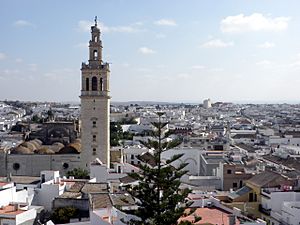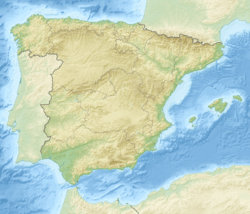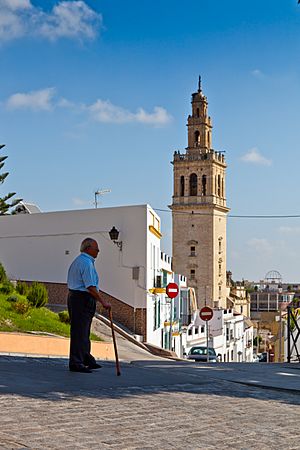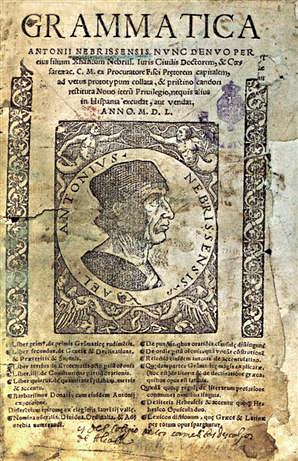Lebrija facts for kids
Quick facts for kids
Lebrija
|
|||
|---|---|---|---|
 |
|||
|
|||
| Country | Spain | ||
| Autonomous community | Andalusia | ||
| Province | Seville | ||
| Area | |||
| • Total | 372 km2 (144 sq mi) | ||
| Elevation | 37 m (121 ft) | ||
| Population
(2018)
|
|||
| • Total | 27,432 | ||
| • Density | 73.74/km2 (190.99/sq mi) | ||
| Demonym(s) | Lebrijanos | ||
| Time zone | UTC+1 (CET) | ||
| • Summer (DST) | UTC+2 (CEST) | ||
| Postal code |
41740
|
||
Lebrija is a city and municipality in Andalusia, a region in southern Spain. It's located in the Province of Seville, near the Guadalquivir river and the marshy area called Las Marismas.
In 2008, Lebrija had about 26,046 people living there. It covers an area of 372 square kilometers, making it one of the largest towns in its province. Nearby towns include El Cuervo and Las Cabezas de San Juan in Seville, and Trebujena and Jerez de la Frontera in the province of Cádiz.
The main activity in Lebrija is farming. Farmers grow crops like beet, cotton, wheat, and various fruits. Making wine is also important, especially types like Manzanilla and other fino wines. Lebrija is also famous for its pottery and earthenware, including special pots called búcaros. Farmers here were the first in Spain to grow corn, which came from the Americas.
Contents
History of Lebrija
People have lived in the Lebrija area since the Bronze Age, a very long time ago. The city itself was likely started by the Phoenicians, who called it Lepriptza. Later, during the time of the Tartessian people, it was renamed Nebrissa.
Originally, Lebrija was a port city on a large inner lake called Lacus Ligustinus. This lake was surrounded by the Guadalquivir River. Over time, the lake filled up with mud and sand, slowly turning into the marshy lowlands we see today, known as las Marismas.
The Romans also knew Lebrija as Nabrissa or Nebrissa Veneria. The word "veneria" means "that which worships" in Latin. This refers to a legend that the god Dionysus (also known as Bacchus) founded Lebrija. The legend says that people in Lebrija especially honored Bacchus with special night ceremonies.
Lebrija, then called Nebrishah, was a strong and busy place when the Moors ruled Spain (from 711 AD). King St Ferdinand took it in 1249, but it was lost again. Finally, it became part of the Castilian crown under King Alfonso the Wise in 1264.
Lebrija is the birthplace of Antonio de Nebrija (1444–1522). He was a very important leader during the Renaissance in Spain. He wrote the first grammar book for a modern European language, which was Spanish. He also taught Queen Isabella and helped create a famous Bible called the Complutensian Polyglot Bible.
Lebrija officially became a city in 1924.
Workers' Movement in Lebrija
In 1903, the first big workers' strike in Lebrija was recorded. During the Spanish Second Republic (a time when Spain was a republic before the Civil War), Lebrija was a strong supporter of the Frente Popular, a group of left-wing political parties. Before that, it was a center for Anarchist ideas, where people believed in a society without government.
During this time, some farms were shared by workers, and land was taken from owners who didn't use it. This was part of a plan to change how land was owned and used. However, these changes stopped when the army rebelled, which led to the Spanish Civil War. The war ended with Francisco Franco and his supporters winning.
In the 1960s and 1970s, Lebrija, along with other towns, became a place where Jornaleros (farm laborers without land) protested. They were struggling with poor living conditions. Because of these protests, a system was set up to guarantee them a minimum wage for a few months each year.
After Francisco Franco's death in 1975, on January 6, 1976, about a hundred jornaleros gathered in the local church to share their demands. They were later removed by the Civil Guard, but not before they used the church loudspeakers to announce their wishes. They wanted unused fields to be given to laborers, year-round support for the unemployed, fair agreements for all workers, and freedom for unions and political prisoners.
Main Sights to See
Lebrija has many old buildings that show its Muslim past. Its most important buildings include a ruined Moorish castle and the main church, Santa María de la Oliva. This church is one of the most beautiful in the province of Seville. It mixes different styles like Mudéjar, Renaissance, and Baroque, and was built between the 14th and 16th centuries. It also has some early carvings by Alonso Cano (1601–1667), a famous artist.
The church's bell tower was inspired by the Giralda tower of the Cathedral of Seville. People often call it "La Giraldilla" (which means 'little Giralda').
The Casa de la Cultura (Cultural Center) was built in the 18th century in a fancy Andalusian Baroque style. It was first used to store wheat for the Archbishop of Seville and as housing for local church leaders. The church used to keep the taxes and tributes paid by the townspeople here. In 1982, the Lebrija City Council bought the building and started to fix it up. It reopened in 1986 as the "Casa de la Cultura," a place for learning, art shows, and all kinds of cultural events, including dance and music.
The Convent and Church of San Francisco (built in 1585) has always been connected to the Franciscan Order, a group of monks. It's located in Plaza Manuela Murube, a very beautiful and artistic spot in Lebrija. In the same square, you can find the Old Hospital of Mercy (Hospital de la Misericordia) and Saint Andrew's Asylum (Asilo de San Andrés).
Culture and Celebrations
The Cruces de Mayo (Holy Crosses of May) is the most famous and popular festival in Lebrija. It happens during the first two weekends of May every year. It's a community event where each neighborhood sets up a cross. These crosses can be permanent stone crosses or new ones built with flowers, iron, or wood. People then gather around these crosses to dance and sing, especially a local type of Sevillanas called Sevillanas corraleras.
The local annual fair is held around September 12th. It celebrates the patron saint of Lebrija, Our Lady of the Castle.
The Júas festival (which is how people in Andalusia say "Judas") takes place on Saint John's Eve. Local people get together and make life-sized rag dolls that look like famous people or local politicians. These dolls are left outside houses for everyone to see. At midnight, they are set on fire, along with fireworks, to end the celebration.
Just like in Seville and other towns in Andalusia, Lebrija has several hermandades, or religious brotherhoods. These groups march in procession, carrying pasos. These are large, lifelike sculptures made of wood or plaster that show scenes from the Passion of Jesus Christ or images of the Virgin Mary. Two of the most important brotherhoods are Los Dolores and El Castillo.
Lebrija is also a center for flamenco music and dance. Every July, it hosts the Caracolá, one of the biggest flamenco festivals in Spain.
Famous People from Lebrija
- Ibrahim bin Ali bin Ahmad (died 1240) - A Muslim scholar who shared important religious stories.
- Antonio de Nebrija - A grammarian who wrote the first grammar book for the Spanish language. He was born in Lebrija.
- Juan Díaz de Solís - A famous navigator and explorer who discovered and named the Rio de la Plata river mouth.
- Juan Bernabé (1947–1972) - A writer and director for the theater.
- Juan Peña "El Lebrijano" - A well-known flamenco singer.
- Juan Ramón López Caro - A former manager of the famous Real Madrid Football Club.
- David Peña Dorantes - A flamenco composer and pianist.
- Benito Zambrano - A modern filmmaker.
Images for kids
See also
 In Spanish: Lebrija (Sevilla) para niños
In Spanish: Lebrija (Sevilla) para niños







